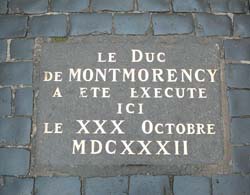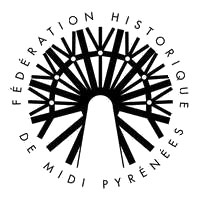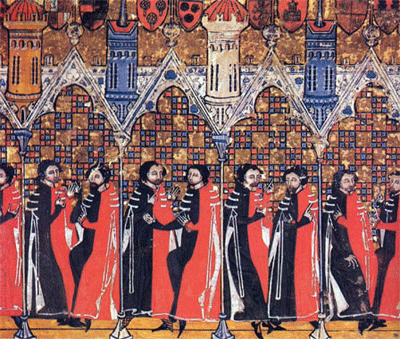Things to See in the Languedoc: Historic Cities: Toulouse
(  Tolosa)
Tolosa)



 From
the eleventh century Toulouse became an important centre,
a focus for financial activity and major stopping point
on pilgrimage routes to Compostella. In the twelfth
century a city council was formed - a unique arrangement
for the time based partly on the Roman Senate. Powerful
merchants and financiers became senhors del Capitol
(Lords of the Chapter) sharing power with the Counts
of Toulouse - a symbiotic relationship which suited
everyone involved, but which would horrify the feudal French
when they annexed the county. Even so, even to this
day the City Hall is known as the Capitol and councilors
are known, uniquely, as Capitouls. They are still
proud to use the device of the ancient rulers, the famous
Cross
of Toulouse . From
the eleventh century Toulouse became an important centre,
a focus for financial activity and major stopping point
on pilgrimage routes to Compostella. In the twelfth
century a city council was formed - a unique arrangement
for the time based partly on the Roman Senate. Powerful
merchants and financiers became senhors del Capitol
(Lords of the Chapter) sharing power with the Counts
of Toulouse - a symbiotic relationship which suited
everyone involved, but which would horrify the feudal French
when they annexed the county. Even so, even to this
day the City Hall is known as the Capitol and councilors
are known, uniquely, as Capitouls. They are still
proud to use the device of the ancient rulers, the famous
Cross
of Toulouse .
  An important pilgrim route, the Via Tolosana (marked in blue on the right) led through Arles, St-Gilles, Saint-Guilhem-le-Désert and Toulouse and crossed the Pyrenees to join other routes at Puenta-la-Reina, thence to Santiago along the Via Compostelana to Santiago de Compostela. An important pilgrim route, the Via Tolosana (marked in blue on the right) led through Arles, St-Gilles, Saint-Guilhem-le-Désert and Toulouse and crossed the Pyrenees to join other routes at Puenta-la-Reina, thence to Santiago along the Via Compostelana to Santiago de Compostela.
Another route, the Regordane (marked in green), led from Le Puy-en-Velay to St-Gilles, by way of the Cévennes, Alès and Nîmes. Some pilgrims came only as far as St-Gilles, the fourth most important pilgimage destination in Europe. Others went on to Santiago de Compostela along the Via Tolosana possibly taking a detour to Saintes-Maries-de-la-Mer (While Compostela claimed the relics of St-James, Saintes-Maries-de-la-Mer claimed the relics of his mother, Mary)
|
|
Pilgrims and hikers still walk these ancient pigrimage routes. Click on the following external link for more information on walking the Regordane  |
|
"…The ingrained
corruption of abominable heresy continues to grow in Toulouse, breeding monstrous
offspring... ulcers that do not respond to dressings must be cut out with a knife...
Those who hold cheap the correction of the Church must be crushed by its power."
    Some
notable events concerning the city included a Cathlic-Cathar
debate in 1145, an unsuccessful siege by Simon
de Montfort in 1211, the rendition to the French
Crusaders and establishment of Dominic
Guzmàn's Dominican Order in the City in 1215,
the revolt of the population against the French in 1216,
the triumphal return of Raymond
VI of Toulouse on 13 September 1217, a second
siege by Simon de Montfort in 1218 during which he was
killed, a third unsuccessful siege this time by Prince
Louis in 1219. For further information about the role
of Toulouse in the Cathar wars, click here Some
notable events concerning the city included a Cathlic-Cathar
debate in 1145, an unsuccessful siege by Simon
de Montfort in 1211, the rendition to the French
Crusaders and establishment of Dominic
Guzmàn's Dominican Order in the City in 1215,
the revolt of the population against the French in 1216,
the triumphal return of Raymond
VI of Toulouse on 13 September 1217, a second
siege by Simon de Montfort in 1218 during which he was
killed, a third unsuccessful siege this time by Prince
Louis in 1219. For further information about the role
of Toulouse in the Cathar wars, click here
|
The
central suporting pillar ("the Palm")
in the Jacobins Church
|
|
|

|
|
|
View
of Toulouse from the Gesta Tholosanorum
(1515) by Nicolas Bertrand
The figure in the centre is the fictional founder
of the city, a descendant of of Japhat. On the
left is the then newplague hospital of Saint
Sebastien
|
|
|
|
|

|
|
|
This
is apainting of the wife Toulouse of a Toulouse
pastel mercant called Lancefoc. Her name was
Paule de Vigier (1518 - 1610). Her extraorinary
beauty was widely recognised. King Francois
I called her La Belle Paule.The Duc de Montmorency
called her a wonder of the world. The Capitouls
of Toulouse, in formal Chapter, decreed that
she must appear in public on the balcony of
the Capitole once a week to allow herself to
be admired, which is the subject of this painting
by Henri Rachou
|
|
|
|
Toulouse lies on the Canal du Midi, built by Pierre-Paul Riquet a notable Languedoc resident. The Canal is popular for boating holidays and through France's extensive canal network provides a way to get to the Languedoc from the Atlantic Ocean, Northern France and Mediterranean Sea.
Click on the following link for the
role of Toulouse in the Cather Wars (Albigensian Crusade)

|
|
 Back to last city
Back to last city |

|
Next Page: Next
City 
|
|
|

![]()


![]()
![]() First
is has to be said that Tolouse no longer has any official
connection with the modern Languedoc. However the
historical links are strong, and 800 years of political
machinations designed to break them have failed.
First
is has to be said that Tolouse no longer has any official
connection with the modern Languedoc. However the
historical links are strong, and 800 years of political
machinations designed to break them have failed. 



















